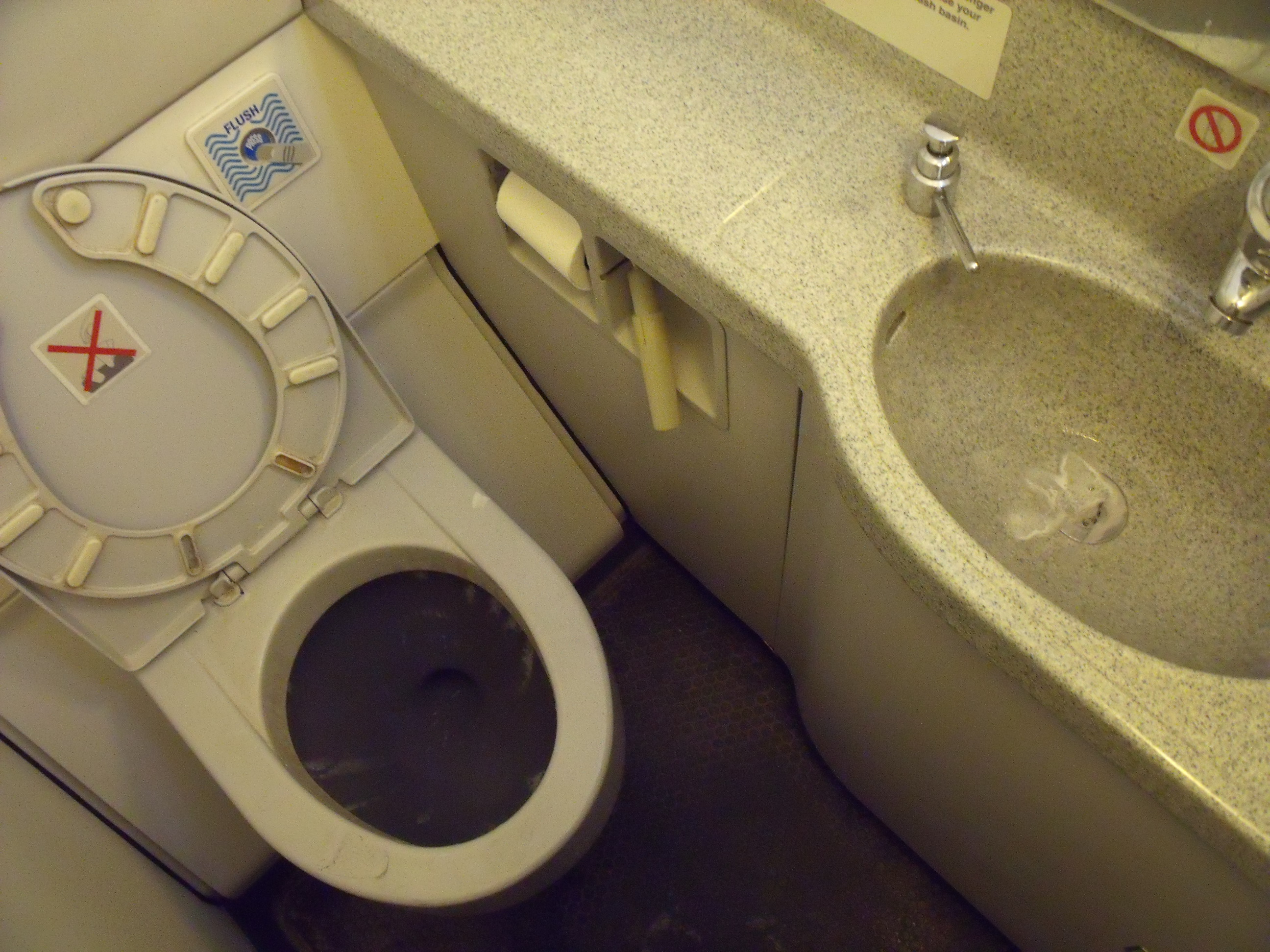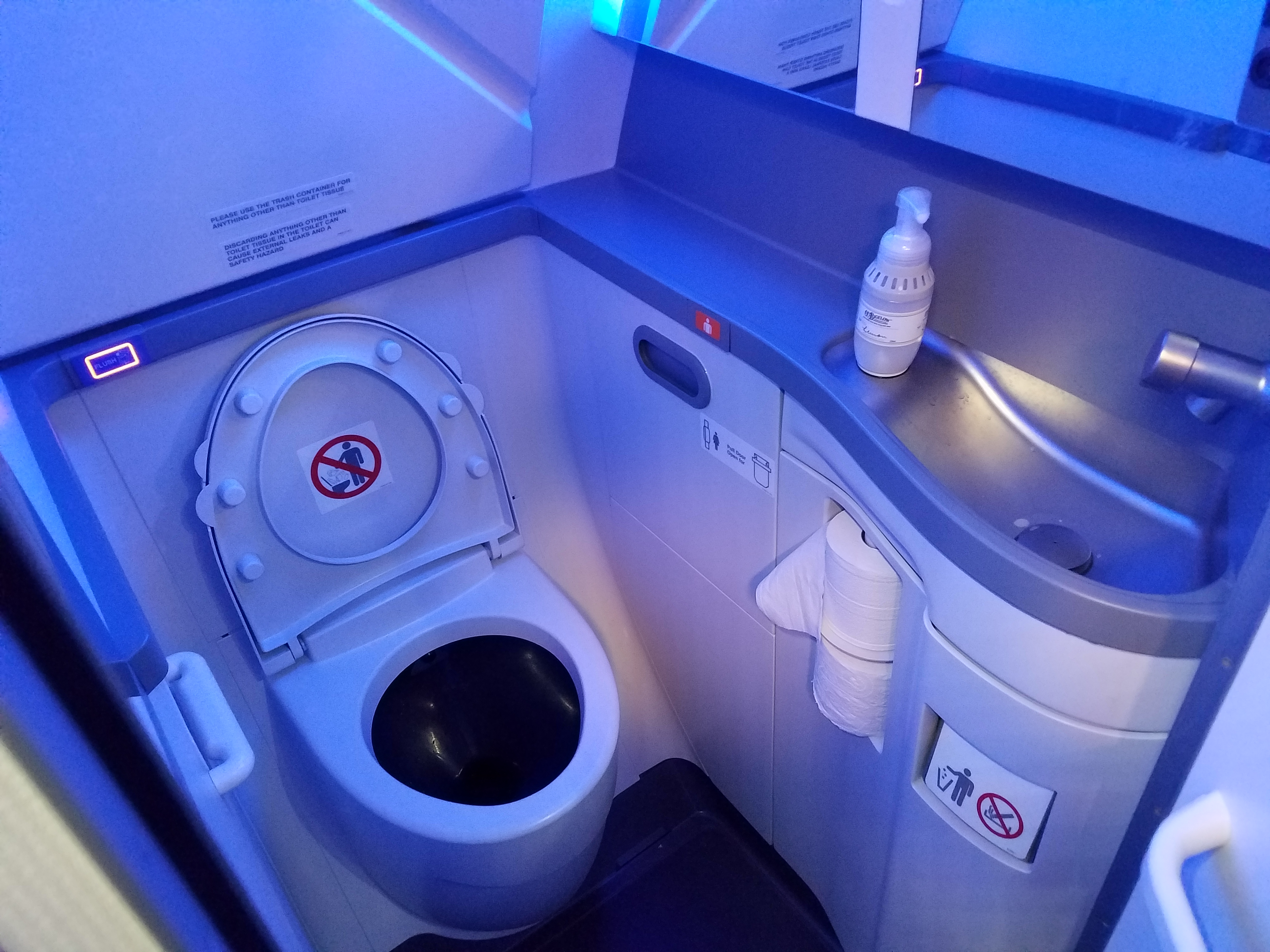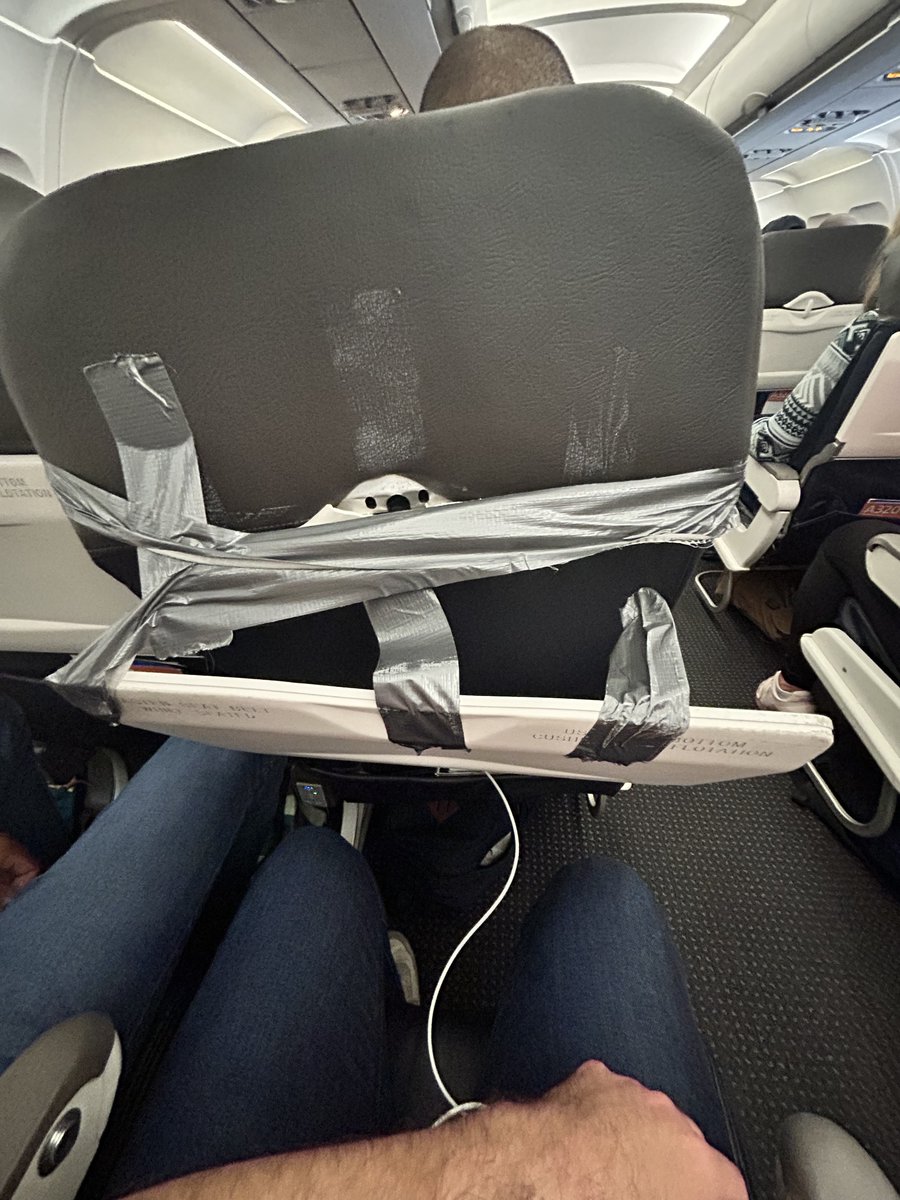On Thursday, American Airlines flight 835 from Tampa to Philadelphia went out without working water. According to a passenger on the flight, a gate agent announced that everyone should use the airport restrooms prior to boarding the scheduled 2 hour 41 minute trip (which doesn’t include 35 minutes spent boarding or time deplaning).
The customer found this – and the nonchalant way they reported the gate agent conveying the message – “ridiculous” and note that the aircraft “was sitting at [Tampa] all night” where the issue could have been addressed. It is possible that the issue developed overnight.
[T]he gate agent told everyone in the gate area that the bathrooms would not be available on the flight and acted like that was just normal and perfectly fine. And yes, it’s a 2.5 hour flight, but if you’ve flown so many miles, then you surely know that flights can end up sitting on the tarmac for quite long holds if there are weather delays, maintenance delays, no gates available, etc. I don’t understand how anyone who flies a lot could feel comfortable getting on a plane where they were told they couldn’t use a bathroom.

Once in the air, though, “It was not until we got on the plane that the flight attendants told us they “thought” we could use the bathrooms in flight but that we would have to use bottled water to flush them, and even then they admitted they didn’t know if it would work.”
What’s odd is that using bottled water to flush is not at all how airplane toilets work. There’s no tank on the lavatory toilet to dump the water into!
A recent video by an American Airlines mechanic explains how lavatories work. And a commenter offers this summary of the issue.
Under 16k feet there’s a vacuum pump that creates the suction to empty the toilet bowl. Above that differential pressure is used to create the vacuum. If the pump wasn’t working that would explain why the lavs wouldn’t work on the ground. Kinda surprised that they could dispatch the plane if the pump was inop.
Now, lavatory functionality is a little bit outside of my area of expertise. But my impression was that modern aircraft use vacuum flush systems that operate the same way regardless of altitude, with a vacuum pump (or ejector system) continuously maintaining the necessary negative pressure in the waste tank.
That vacuum isn’t “switched” off below 16,000 feet so that the pump does all the work on the ground and then differential pressure takes over above that altitude. Instead, the system is engineered to work both on the ground and in flight—the vacuum pump (or vacuum ejector) overcomes the higher ambient pressure on the ground and then works in concert with the pressure differential in flight.
Usually if the pump were inoperative, the system wouldn’t work properly at any altitude. However, if a component of the vacuum system—like the pump, valves, or seals—is marginal, cabin pressurization at altitude might assist a weak or partially failing vacuum pump, providing enough suction for the flush. On the ground, the same system might not generate a sufficient vacuum if its performance is degraded.
This would be caused by a weak or failing vacuum pump or valves that might not open or seal properly at sea-level pressure, but at altitude the pressure differential is enough to overcome those deficiencies.

The aircraft continued to operate on Thursday from Philadelphia to Chicago, back to Philadelphia, and down to Charlotte before heading to Wilmington, North Carolina to overnight.
The plane was N119US, a 25-year old Airbus A320 delivered to US Airways in 2000. Perhaps some aircraft mechanic readers can weigh in if older A320 lavatories did work the way originally described? I find this suddenly fascinating.
Of course, poor passenger experience across the board is the sine qua non of the basket of deplorables aging American Airlines A320 fleet. Older planes can be fantastic if they get the proper upkeep and investment which these haven’t (though are eventually slated to because they aren’t planned for retirement in the next few years).

American Airlines has flown New York to Chicago without a lavatory before but passengers knew in advance they’d have to hold it for the duration of the trip. (On a flight to Hawaii, American told passengers to go in a bottle when the lavatories became inoperable.)
There’s a certain length of flight where you might choose not to delay or cancel over a lavatory. At least passengers knew about the issue in advance and could make a quick calculation over whether they’re capable of flying under those conditions (some may even be wearing Depends!). However longer flights will certainly cancel.


I am sure those old AW 320’s being parked at Roswell for ages could have exacerbated any seal ageing issues.
At some point a decision needs to be made whether to take the a/c out of service. Planes break. Normally they would put wipes in the bathroom and provide bottle water. This is 2.5 hour flight, not a five hour flight. So they could take the a/c out of service and passengers would miss connections at PHL and would be problematic for those passengers with time sensitive travel.
So pick your poison. TPA isn’t a hub so there’s no spare a/c sitting around.
It sounds more like the water to the lavatory bowls may of had an issue and was shutoff. This falls under the MEL for an Airbus. The water is just their to rinse and assist with movement of solids, so putting some water in the bowl from a bottle would provide that same functionality. abnormal, yes, but doable and not worth delaying a flight over As for the vacuum pump, It is designed to create the negative pressure at lower latitude when the cabin differential pressure isn’t enough to create the “suction”. Without it the differential pressure isn’t enough to flush (create suction) until around 16,000ft. above that the toilet would function normally. This vacuum pump MEL is actually pretty common. I am with George Romey on this. Do you want to miss you connection and be delayed or would you rather have to pour a bit of water in the toilet before you flush and run on time. Seeing as how TPA isn’t a hub or mx base for AA, they probably don’t have any parts to fix this there and would incur quite the delay sending parts.
Maybe AA’s gonna start selling Depends!! Coffee, Tea… Depends?
AA should have AAdvantage branded empty plastic bottles.
This happened recently on Delta: https://viewfromthewing.com/delta-passengers-told-to-use-a-water-bottle-after-plane-flies-around-without-working-bathrooms/
@George. My prostate disagrees with you. 2.5 hour flight plus boarding and taxiing and disembarking equals 3.5-4.0 hours without a pot to piss in. That’s a no go for me
I see my comment was deleted because it went against your narrative even though it was grounded in facts
@Gary
Glad AA let the passengers decide under the circumstances–I presume each passenger could make their own decision (accept the conditions, or rebook, or refund).
If the airline had canceled or significantly delayed, it’s a shame we do not have passenger protections like EU261/APPR because then all those passengers would have been compensated for the inconvenience.
Also, your knowledge of the aircraft lavatories is second to none, other than maybe the people who actually service them.
Finally, what a splendid ‘basket of deplorables’ reference–Correct both times, these old-ass a320s and the bigots. Now, where’s @Andy S and @Mantis so they can get offended.
@Larry, I’m not sure where you learned your anatomy. Urine isn’t stored in the prostate
@dispatch – no, i did not delete your comment
@Dick — prostate conditions can absolutely affect the need to urinate. Not to go into too much detail on a travel forum but for example an enlarged prostate can push against the bladder leading to an urge to urinate despite the bladder not being that full.
There’s also a psychological issue at play. For many people the realization that you don’t have the opportunity to urinate (i.e. in this case where there’s no available bathroom, or when the plane is descending and no one is allowed to get up) can cause anxiety, exacerbating the need to urinate.
@Dick
You, of all people, should know better. Pee is stored in the balls, obviously. Right, dick…I mean, Dick? Seriously, though, if you have an enlarged prostate, you definitely ‘feel’ the need to go more frequently. Then again, those of us with ‘flight anxiety’ often need to race like piss-horse…ahh, did it again.
@Dick no it is not but due to its position near the urinary tract prostate issues can cause you to need to urinate more often or cuz urinary incontinence.
Boat Captain here. Definitely a tampon stuck in the vacuum pump.
American is becoming the Greyhound of the skies instead of Southworst. I flew coach on one of their new 737s and can’t imagine that Spirit or Frontier have smaller seats.
Just knowing that I couldn’t pee for 2.5 hours would make me have to pee. I have an anxious bladder. I pee 3 times just waiting out the 2 hours in the airport before the flight
There hasn’t been a decent bathroom on an airplane in 20 years. The joke used to be “mile high club” because you could hold a party in each one — now they are stand-up broom closets with any decorum gone the way of the ability to recline seats without putting your head in the lap of the person behind you. Oh forgot — “in coach”, because our airlines want to make it so horrendous that you will pay triple to fly in the front of the plane.
@Dick As a middle aged guy with prostate issues, the tube through which you urinate becomes constricted and gives you a sense of urgency to urinate so you do not have the ability to go when you want and does not let you empty your bladder fully when you wish you could, but rather when your body tells you it is time. Personally, I could not last 2.5 hours with no lavatory visit.
I cannot imagine their being a legitimate excuse for this other than very shoddy management of aircraft maintenance. Its an appalling situation.
Maybe the new president will fix it – in One day ?
This is not an “American Airlines” issue. This happens to all airlines because all airplanes can have maintenance issues. Some require that the a/c go immediately out of service because of the safety risk. Some (like this) require a judgement call. Had this been much more than a 3 hour flight likely the a/c would have gone out of service and passengers rebooked at best as could be expect with 90% load factors.
Everyone wants Frontier/Spirit fares at 1970s service levels. In particular you see this on travel blogs where you would think people would know this combination isn’t possible. Next time AA can simply cancel the flight and people can stand at line at the podium (no rebooking desk at TPA) or the AC trying to get on other flights and for a few potentially lose their upgrade or their paid first class seat.
I have a solution to the out-of-order American Airlines aircraft toilets. During my visit to one of the American Express Centurion lounges (PHX), I noticed they offer complimentary bottles of S. Pellegrino Sparkling Natural Mineral Water. This sparkling water, known for its natural effervescence, is perfect for flushing urine and fecal matter found in out-of-order toilets on American Airlines flights. However, not all guests in the AMEX Centurion lounges are worthy of receiving sparkling water bottles; only those with a Black AMEX Centurion card can enjoy this benefit. If you are a lower-valued AMEX Platinum cardholder who chose not to pay the $10,000 initiation fee for the Black card if you received an invitation, the bartender will fill a paper coffee cup with regular sparkling water from the bar 8-flavor soda gun. Now, you can be a problem solver and help the flight attendants flush the broken aircraft toilets on your next American Airlines flight.
In 2002, I was on THREE American Airlines flights which we were told had “no working bathrooms on board”. We were told to use the restroom In the airport before boarding. All three flights were in or out of Dallas.
. I would say this is a no-go item. Health and safety!
I was on a United flight last summer which was delayed about an hour because the bathroom in the coach section was not working. But the issue was resolved and we took off within further problems.
Maybe the no working bathrooms are a trial run of the way things will be handled in the future. No working bathrooms being a feature on flights of less than 1000 miles even if the mechanisms are ok so that the repair labor costs can be reduced.
I had 4 AA flights over the holidays and one of them was a no lav flights, but just in first class. Walking all the way to the back of the plane reinforced by immense pleasure at being fortunate enough not to have to sit back there for the 20+ years. No one looked happy.
I used to fly, now I just drive . I’m lucky that I don’t have to travel for business anymore. I hate flying with a passion because of this this type of unprofessional service.
I had a flight canceled because the light in the lavatory didn’t work. How could they allow the flight if the bathroom didn’t work?
@Donald
Well, they saw you, then scowled–no wonder!
Where was the Captain, God bless him, on this deal? I flew for a major for 34 years, and knowing that folks couldn’t use the lav for more than 2 hours would be a no go, for everyone and I have made it happen, more than once, with maintenance control supporting that decision. That two hours could turn into way more. An hour or so …ok. There’s lots of things you possibly could have done, swap airplanes, swap parts, delay, fly a new part in, etc. Voice of experience speaking here. At least they were told and had another option….take another flight, go the next day even. I learned to refuse to take an airplane for three reasons, …any item of safety i was not comfortable with,… and lavs not working properly, keep in mind they can overflow too and make a mess. And the big one is taking an airplane with a compromised pressurization system utilizing the APU for pressurization, thus restricting the altitude at which you can fly. On a hot summer day you may find yourself bouncing along in cumulus clouds continuously, making for an extremely uncomfortable ride, and you will come to understand the meaning of “we rode the vomit comet” for three hours! Perfectly legal, but not a good choice. Again, the input of the crew, especially the P.I.C. means alot….that’s what they were hired for!!
What a misleading headline! Why should airplane bathrooms be available before boarding?
Honestly, it looks like someone looked at a defect (no running water) and came to the wrong conclusion (toilets won’t flush) because that’s how their toilet at home works. Probably the toilets worked fine and all that was needed was extra bottled water for tea & coffee and hand sanitizer for washing. Source: I work for an airline and have seen things like this before.
@Vazir Mukhtar
Gary’s title makes sense to most native English speakers. Perhaps, it didn’t translate well in Russian or Farsi (nice username—why not go with Pushkin or Tolstoy next time?)
I can’t imagine fliers peeing in a plastic bottle when they can’t his something the size of a toilet bowl. Ick ick ick!
At least the passengers got some notice. I have sat in the secure gate area at Doha for more than an hour. Due to boarding process. Then waiting on the plane before take off then waiting for at least 45 minutes for cabin crew to finally check with the cockpit to see if the fasten seatbelt light could be turned off. This was after multiple people attempted to use the lavatory. All this on the world’s best airline. They weren’t on that trip.
Reminds me of when I flew on Northwest from Honolulu to Portland. Of course the plane was larger than a 320 (757) and flight time was nearly six hours. This was right before the Delta merger. I guess the Captain figured to go ahead and fly. There were 3/4 bathrooms working. I never had a problem, but it was a red eye. ugh!
The vacuum motor runs until 16’000 ft at which time an altitude switch disables the motor & differential pressure is used to flush the toilets. If the the motor fails, the toilets will still operate when you get above 16,000 ft. Airplane parts are incredibly expensive, and it’s hard to keep parts where they are needed. Nobody wants to hear that, but that’s the truth.
@gary. you created an entire article based on a water bottle and an FA? really….
@steve
What a gross oversimplification of Gary’s fine work product here. Are you blind to his extensive findings on the inner-workings of aircraft lavatories? This is *peak* VFTW content. Live a little!
All bran muffins and coffee shall be confiscated unless you can prove you are wearing a Depends.
I like @Steve way more than @steve.
Upper-case ‘S’ Steve gets it! Fun guy.
Lower-case ‘s’ steve is a dweeb. Boo.
Be a Steve, not a steve.